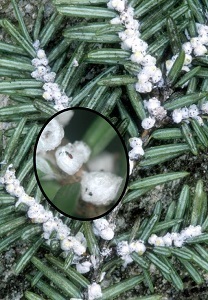|
The following news release was issued earlier today by the Michigan Department of Agriculture and Rural Development.
For immediate release: August 1, 2024
Media contact: Jennifer Holton, 517-284-5724
Program contacts: Susie Iott, 517-420-0473 or Joanne Foreman, 517-284-5814
LANSING – The Michigan Department of Agriculture and Rural Development recently verified a new detection of invasive hemlock woolly adelgid or HWA on trees on a private property in Leelanau Township in Leelanau County. The extent of the infestation is currently being assessed through survey of the surrounding area. With this new detection, Leelanau becomes the ninth county in the state with active hemlock woolly adelgid infestations, joining Allegan, Antrim, Benzie, Mason, Muskegon, Oceana, Ottawa and Washtenaw counties.
“This infestation was discovered by the Northwest Michigan Invasive Species Network,” said Molly Mott, MDARD’s Plant Health Section manager. “Situations like this highlight the crucial role public awareness plays in our fight against invasive species.”
To help slow the spread of HWA, Leelanau County has been added to the statewide hemlock woolly adelgid quarantine. The quarantine restricts the movement of hemlock nursery stock and unprocessed hemlock material from quarantined areas.

Hemlock woolly adelgid is a small insect that uses its long, siphoning mouthparts to extract sap from hemlock trees. Its feeding can cause needles and buds to die. Over time, canopies thin, trees take on a grayish-green appearance and growth slows. Without treatment, infested trees die within four to 10 years.
“This invasive pest represents a significant threat to the estimated 170 million hemlock trees growing in Michigan forests. Hemlocks are important ecologically, provide essential wildlife habitat and help to stabilize dunes,” said Deb McCullough, Michigan State University Professor, Department of Entomology and Department of Forestry.
Infested trees can be identified by looking on the undersides of hemlock branches for evidence of round, white ovisacs near the base of the needles. Up close, ovisacs resemble cotton balls and may appear alone or in clusters. For assistance in identification, see the short video, "Hemlock Woolly Adelgid: Invasive Species in Michigan."
|
It's important to note that other, less damaging pests can be mistaken for hemlock woolly adelgid. Be sure to review photos and descriptions of common hemlock woolly adelgid look-alikes at Michigan.gov/HWA. Help in identifying hemlock trees is also available at the same site.
“Hemlock woolly adelgid likely arrived in Michigan on infested nursery stock from northeastern or mid-Atlantic states. Although the tiny insects don’t move far on their own, they can be blown by wind or hitchhike on birds or animals. In a similar way, cars, boats or RVs parked under infested trees may be able to transport the insects to new locations,” added Mott. “If you’re headed outdoors, take precautions like only parking in designated areas, cleaning gear and vehicle before traveling and leaving firewood at home.”
Suspected infestations in Leelanau County or new areas of the state can be reported by:
Be prepared to report the location of infested trees and, whenever possible, take one or two pictures of infested branches to help confirm identification. To avoid spreading hemlock woolly adelgid, do not collect sample branches or twigs.
For more information on hemlock woolly adelgid and other invasive species in Michigan, and to find out what you can do to help prevent them, visit Michigan.gov/Invasives.
Michigan's Invasive Species Program is cooperatively implemented by the Department of Environment, Great Lakes, and Energy; the Department of Natural Resources; and the Department of Agriculture and Rural Development.
Note to editors: Accompanying photos are available below for download. Caption information follows.
Ovisac: Tiny hemlock woolly adelgids build round, white ovisacs to protect their eggs. Ovisacs are most visible from fall to spring on the underside of hemlock branches. Photo courtesy of Lorraine Graney, Bartlett Tree Experts, Bugwood.org./
Infested branch: Round, white hemlock woolly adelgid ovisacs are found on the undersides of branches near the base of the needles.
Hemlock branch: Hemlock trees have small, papery cones and short needles that are dark green on top.
|